My journey has become ever more challenging thanks to a growing list of diseases, syndromes, and comorbidities. I've gone from 2 (Psoriasis and Psoriatic Arthritis) to 20 in the past seven years! Yes, that's right; I have 20 health issues requiring daily management, severely affecting my quality of life. Five years ago, I was only taking two medications: A biologic drug that I self-injected every two weeks and Prednisone. I'm now taking 13 different medications daily, with some spread out in 3 doses throughout the day.
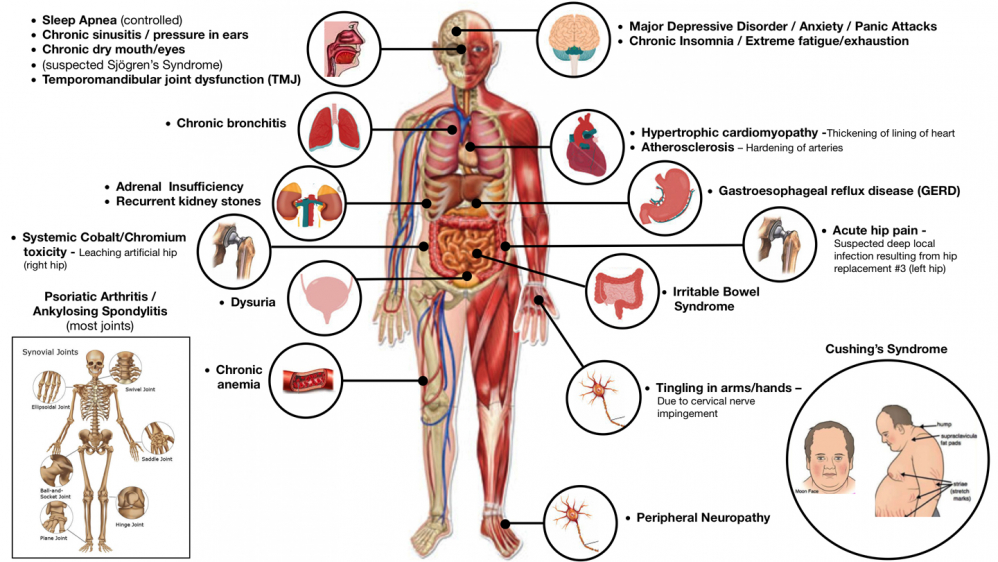
AUTO-IMMUNE ILLNESSES
-
Psoriatic Arthritis
Psoriatic arthritis is a long-term inflammatory arthritis that occurs in people affected by the autoimmune disease psoriasis. The classic feature of psoriatic arthritis is swelling of entire fingers and toes with a sausage-like appearance. Wikipedia
-
Ankylosing Spondylitis
Ankylosing spondylitis is a type of arthritis in which there is long term inflammation of the joints of the spine. Typically the joints where the spine joins the pelvis are also affected. Occasionally other joints such as the shoulders or hips are involved. Eye and bowel problems may also occur. Back pain is a characteristic symptom of AS, and it often comes and goes. Stiffness of the affected joints generally worsens over time. Wikipedia
-
Sjögren’s Syndrome
Sjögren's syndrome is a long-term autoimmune disease in which the moisture-producing glands of the body are affected. This results primarily in the development of a dry mouth and dry eyes. Other symptoms can include dry skin, vaginal dryness, a chronic cough, numbness in the arms and legs, feeling tired, muscle and joint pains, and thyroid problems. Those affected are at an increased risk of lymphoma. Wikipedia
In the fall of 2020, I was diagnosed with Meibomian gland dysfunction and blepharitis. These two conditons are compications of Sjögren's and can be quite debilitating at times.

POLYGLANDULAR AUTOIMMUNE SYNDROME (ENDOCRINOLOGICAL)
-
Secondary Adrenal Insufficiency
Secondary adrenal insufficiency is due to the absence of the normal stimulation to the adrenal cortex from a lack of ACTH. This results in a partial or total deficiency of cortisol, but often a normal or near normal production of aldosterone.
The symptoms are related to the degree of cortisol deficiency, the underlying health of the individual, and the rate of reduction in cortisol level. The most common symptoms are:
- severe fatigue
- loss of appetite, weight loss
- nausea, vomiting, and diarrhea
- muscle weakness
- irritability and depression
-
Low testosterone
Some men have low testosterone levels. This is called Testosterone Deficiency Syndrome (TD) or Low Testosterone (Low-T). Deficiency means that the body does not have enough of a needed substance. Syndrome is a group of symptoms that, together, suggest a disease or health condition.
- Low sex drive
- Fatigue
- Reduced lean muscle mass
- Irritability
- Erectile dysfunction
- Depression
- There are many other possible reasons for these symptoms, such as: opioid use, some congenital conditions (medical conditions you are born with), loss of or harm to the testicles, diabetes, and obesity (being overweight). See your doctor if you have any of these symptoms.
www.urologyhealth.org
-
Hypothyroidism
Hypothyroidism, also called under-active thyroid or low thyroid, is a disorder of the endocrine system in which the thyroid gland does not produce enough thyroid hormone. It can cause a number of symptoms, such as poor ability to tolerate cold, a feeling of tiredness, constipation, depression, and weight gain. Wikipedia
-
Cushing's syndrome (Cushingoid's)
Cushing's syndrome is a collection of signs and symptoms due to prolonged exposure to cortisol. Signs and symptoms may include high blood pressure, abdominal obesity but with thin arms and legs, reddish stretch marks, a round red face, a fat lump between the shoulders, weak muscles, weak bones, acne, and fragile skin that heals poorly. Women may have more hair and irregular menstruation. Occasionally there may be changes in mood, headaches, and a chronic feeling of tiredness. Wikipedia
-
Prediabetic
Prediabetes refers to blood sugar levels that are higher than normal, but not yet high enough to be diagnosed as type 2 diabetes. Almost 6 million Canadians have prediabetes.
If left unmanaged, prediabetes can develop into type 2 diabetes—but it doesn't have to be this way. If you have prediabetes, taking steps to manage your blood sugar can change your future to one free of type 2 diabetes.
More info: https://www.diabetes.ca/recently-diagnosed/prediab...
UROLOGICAL AND NEUROLOGICAL CONDITIONS
-
Stage 3a Kidney Disease
Kidney disease is a severe condition in which your kidneys slowly start to fail. This leads to a build-up of harmful elements in your blood that would otherwise be filtered out through your kidneys. If kidney disease progresses, you would eventually need to get dialysis or a kidney transplant to remain alive.
Stage 3 kidney disease means that the kidney’s function has been cut by half, and most patients experience ancillary problems like high blood pressure or bone difficulties.
More info: https://www.webmd.com/a-to-z-guides/what-is-stage-...
-
Neurogenic bladder
Neurogenic bladder dysfunction, sometimes simply referred to as neurogenic bladder, is a dysfunction of the urinary bladder due to disease of the central nervous system or peripheral nerves involved in the control of micturition (urination). Wikipedia
-
Peripheral neuropathy
Peripheral neuropathy, often shortened to neuropathy, is a general term describing disease affecting the peripheral nerves, meaning nerves beyond the brain and spinal cord. Damage to peripheral nerves may impair sensation, movement, gland or organ function depending on which nerves are affected; in other words, neuropathy affecting motor, sensory, or autonomic nerves result in different symptoms. More than one type of nerve may be affected simultaneously. Peripheral neuropathy may be acute (with sudden onset, rapid progress) or chronic (symptoms begin subtly and progress slowly), and may be reversible or permanent. Wikipedia
-
Cobalt and Chromium poisoning from a leaching metal-on-metal hip
Cobalt poisoning is intoxication caused by excessive levels of cobalt in the body (in my case, leaching from a metal hip implant). Cobalt is an essential element for health in animals in minute amounts as a component of Vitamin B. A deficiency of cobalt, which is very rare, is also potentially lethal, leading to pernicious anemia. Wikipedia
Chromium toxicity refers to any poisonous effect in an organism or cell that results from exposure to specific forms of chromium—especially hexavalent chromium (in my case, also from the leaching metal hip implant). Hexavalent chromium and its compounds are toxic when inhaled or ingested. Trivalent chromium is a trace mineral that is essential to human nutrition. Wikipedia
I am being tested every 3 months and my levels are just on the borderline of reaching toxicity. Their are 2 options available to address the problem:
- Have the hip implant replaced (which I do not want to do after what I've been through with my unsuccessful hip revision!) This hip, although leaching, is still very functional and reliable and is said to last me for the rest of my life.
- Chelation therapy (something I am waiting to hear back on from my doctors as a posible temporary solution)
CARDIO/RESPIRATORY-RELATED PROBLEMS
-
TMJ (temporo-mandibular joints) joints damaged by Psoriatic Arthritis
My TMJs were damaged during the early stages of the disease (mid 90's). I've been left with an open bite, a 6 milimmiter overjet, paind and stiffness in the joints and surrounding ligaments that attach to the skull, as well as a modified profile (chin is retracted).
Some people with psoriasis and/or psoriatic arthritis can develop problems in the two joints between the skull (temporal bone) and lower jaw (mandible). These are known as the temporo-mandibular joints or TMJs for short. Read more at PAPAA
What problems can occur?
The TMJs are lined with synovial membrane, which can become inflamed in some people with psoriatic arthritis. This can cause symptoms of:- headache
- tender jaw muscles
- pain around the face, TMJ or ear
- pain on opening the mouth wide and when chewing
- joint stiffness
- clicking as the jaw is opened or closed
- difficulty in opening the mouth
- locking of the jaw
-
Sleep apnea and snoring
Sleep apnea is a potentially serious sleep disorder in which breathing repeatedly stops and starts during sleep. This happens when the muscles in the throat relax, blocking the airway. Each pause can last for a few seconds to a few minutes and they happen many times a night. In the most common form, this follows loud snoring. Wikipedia
-
Chronic insomnia
Insomnia, also known as sleeplessness, is a sleep disorder where people have trouble sleeping. They may have difficulty falling asleep, or staying asleep as long as desired. Insomnia is typically followed by daytime sleepiness, low energy, irritability, and a depressed mood. Wikipedia
-
Hypertrophic Cardiomyopathy
Hypertrophic cardiomyopathy is a condition in which a portion of the heart becomes thickened without an obvious cause. This results in the heart being less able to pump blood effectively. Symptoms vary from none to feeling tired, leg swelling, and shortness of breath. It may also result in chest pain or fainting. Complications include heart failure, an irregular heartbeat, and sudden cardiac death. Wikipedia
-
Metabolic Syndrome (Hypertension, High Blood Sugar and Cholesterol levels)
Metabolic syndrome refers to the presence of increased blood pressure, high blood sugar, excess body fat and abnormal cholesterol levels, which increase the risk of heart disease, stroke and type 2 diabetes.
Hypertension, also known as high blood pressure, is a long-term medical condition in which the blood pressure in the arteries is persistently elevated. High blood pressure usually does not cause symptoms. Wikipedia
-
Heart arrhythmia
A heart arrhythmia is an irregular heartbeat. Heart rhythm problems (heart arrhythmias) occur when the electrical signals that coordinate the heart's beats don't work properly. The faulty signaling causes the heart to beat too fast (tachycardia), too slow (bradycardia) or irregularly.
Heart arrhythmias may feel like a fluttering or racing heart and may be harmless. However, some heart arrhythmias may cause bothersome — sometimes even life-threatening — signs and symptoms.
GASTROINTESTINAL CONDITIONS
-
Irritable Bowel Syndrome
Irritable bowel syndrome (IBS) is a group of symptoms—including abdominal pain and changes in the pattern of bowel movements without any evidence of underlying damage. These symptoms occur over a long time, often years. Wikipedia
Symptoms may include:
- pain in the stomach, especially after eating
- bloating
- cramps
- diarrhea
- constipation
- indigestion
- regular feeling of fullness
- gas
- weight loss
-
Gastroesophageal reflux disease (GERD)
Gastroesophageal reflux disease, also known as acid reflux, is a long-term condition where stomach contents come back up into the esophagus resulting in either symptoms or complications. Symptoms include the taste of acid in the back of the mouth, heartburn, bad breath, chest pain, vomiting, breathing problems, and wearing away of the teeth. Complications include esophagitis, esophageal strictures, and Barrett's esophagus. Wikipedia
EARS, NOSE & THROAT
-
Eosinophilic Bronchitis
Eosinophilic bronchitis is a type of airway inflammation due to excessive mast cell recruitment and activation in the superficial airways as opposed to the smooth muscles of the airways as seen in asthma. It often results in a chronic cough. Lung function tests are usually normal. Inhaled corticosteroids are often an effective treatment. Wikipedia
-
Eustachian Tube Dysfunction
What is Eustachian tube dysfunction?
The Eustachian tube is a small passageway that connects your throat to your middle ear. When you sneeze, swallow, or yawn, your Eustachian tubes open. This keeps air pressure and fluid from building up inside your ear. But sometimes a Eustachian tube might get plugged. This is called Eustachian tube dysfunction. When this happens, sounds may be muffled and your ear may feel full. You may also have ear pain.
Symptoms of Eustachian tube dysfunction
- Your ears may feel plugged or full.
- Sounds may seem muffled.
- You may feel a popping or clicking sensation (children may say their ear “tickles”).
- You may have pain in one or both ears.
- You may hear ringing in your ears (called tinnitus).
- You may sometimes have trouble keeping your balance.
MENTAL HEALTH
-
Chronic Illness-Induced PTSD
What Is Illness-Induced PTSD? (and Who Gets It)
“Illness-induced PTSD is defined by clinically significant post-traumatic stress symptoms … which results from an acute or chronic illness,” Renée El-Gabalawy, Ph.D., psychologist.
It’s not just living with scary symptoms that can lead to illness-induced PTSD. Encounters with the medical system, from invalidating doctors to invasive tests, surgeries and other procedures can be traumatizing. Other ways your life changes after a diagnosis, like the financial toll of paying for treatment, job loss and navigating your relationships when others don’t understand what you’re going through, can have a big impact too. In the professional community, however, illness-induced PTSD isn’t as well understood.
Text above taken from: https://www.yahoo.com/lifestyle/know-chronic-illne...
-
Anxiety and Depression
People with anxiety disorders often struggle with intense feelings of anxiety, worry, fear and/or panic. Anxiety can interfere with daily activities and may last a long time. People with depression experience a persistent sad mood that lasts a long time and interferes with daily activities.
UNCATEGORIZED HEALTH ISSUES
-
Familial Multiple Lipomatosis
Familial multiple lipomatosis (FML) is a rare condition that is characterized by multiple lipomas on the trunk and extremities. As the name suggests, FML is diagnosed when multiple lipomatosis occurs in more than one family member, often over several generations. The lipomas associated with FML are usually painless, but may impact quality of life as they can be numerous and large. Although the condition appears to be passed down through families in an autosomal dominant manner, the underlying genetic cause is currently unknown. Treatment is based on the signs and symptoms present in each person. RareDiseases.info
-
Inguinal Hernia (right side)
An inguinal hernia occurs when tissue, such as part of the intestine, protrudes through a weak spot in the abdominal muscles. The resulting bulge can be painful, especially when you cough, bend over or lift a heavy object.
An inguinal hernia isn't necessarily dangerous. It doesn't improve on its own, however, and can lead to life-threatening complications. Your doctor is likely to recommend surgery to fix an inguinal hernia that's painful or enlarging. Inguinal hernia repair is a common surgical procedure.
-
Multiple Chemical Sensitivity (MCS)
Multiple chemical sensitivity (MCS), also known as idiopathic environmental intolerances (IEI), is a chronic condition characterized by non-specific symptoms that the affected person attributes to encountering small amounts of common substances, such as perfume. The etiology, diagnosis and treatment of MCS are controversial and still debated among researchers, but a 2018 systematic review concluded that the evidence suggests that organic abnormalities in sensory processing pathways and the limbic system combined with some specific, uncommon personality traits (such as heightened attentional bias) best explains this condition.[1]
Commonly attributed substances for MCS symptoms include scented products, pesticides, plastics, synthetic fabrics, smoke, petroleumproducts, and paint fumes.[2]
MCS symptoms are typically vague and non-specific. They may include fatigue, headaches, nausea, and dizziness. Although the symptoms of MCS themselves are real, and can be disabling, MCS is not recognized as a separate, discrete disease by the World Health Organization, American Medical Association, or by several other professional medical organizations
Taken from Wikipedia: https://en.wikipedia.org/wiki/Multiple_chemical_se...
JOINTS WITH SIGNIFICANT DAMAGE
-
Torn Rotator Cuff (right shoulder)
In the summer of 2020, I started having pain in my right shoulder. I had it injected with cortisone, and one week later, as I was reaching over in the night to grab something, it felt as if a bomb had exploded in my shoulder. It was one of the most excruciating pains I've ever experienced. X-rays show that both shoulders have been damaged by arthritis. I suspect that the injection weakened the soft connective tissues (this can happen), which led to the tearing. The joint pops and clicks all the time. I've read the radiologist's report of my MRI, and quite frankly, it sounds like there is a lot of damage. My doctor says physio is my only option at this point, given my overall health condition, which is very complex and puts me at great risk if I had surgery.
The rotator cuff is a group of muscles and tendons that surround the shoulder joint, keeping the head of your upper arm bone firmly within the shallow socket of the shoulder. A rotator cuff injury can cause a dull ache in the shoulder, which often worsens with use of the arm away from the body. Read More...
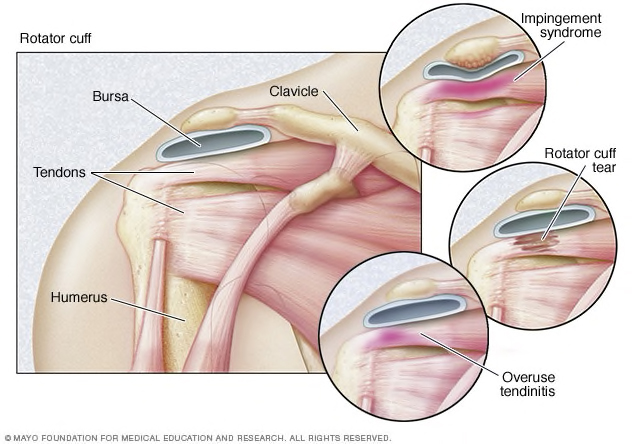
-
Knees
Both knees have significant OA damage and the right nee has meniscus diminishment.
Osteoarthritis is the most common form of arthritis in the knee. It is a degenerative, "wear-and-tear" type of arthritis that occurs most often in people 50 years of age and older, although it may occur in younger people, too.
In osteoarthritis, the cartilage in the knee joint gradually wears away. As the cartilage wears away, it becomes frayed and rough, and the protective space between the bones decreases. This can result in bone rubbing on bone, and produce painful bone spurs.
Osteoarthritis usually develops slowly and the pain it causes worsens over time.
More info: https://orthoinfo.aaos.org/en/diseases--conditions...
-
Cuboid Syndrome
Cuboid syndrome happens when the joint and ligaments near the cuboid bone in your foot become injured or torn. It’s also known as cuboid subluxation, which means that one of the bones in a joint is moved but not fully out of place.
Knowing how to recognize cuboid syndrome and treating it at home can help you avoid further foot injuries.
The most common symptom of cuboid syndrome is pain on the lateral side of your foot where your smallest toe is. This pain might feel sharper when you put your weight on that side of your foot or when you push on the arch on the bottom of your foot.
The pain associated with cuboid syndrome might spread to other parts of your foot, too, when you stand on the front of your toes.
SURGERIES & FUSIONS
-
Bi-Lateral hip replacements (1997 and 2001)
The hip is one of the largest weight-bearing joints in your body. It is shaped like a ball and socket. Total hip replacement is a surgery to replace the ball at the top of the thigh bone (femur) and the hip socket.
Surgeons use metal, ceramic, and/or plastic replacement parts.
Below is an x-ray of both my hips showing the most recent hip revision on the LEFT side (the one with the screw showing.) Unfortunately, the revision was not a complete success. I've been left with what appears to be life long sequela. Symptoms include stiffness and nerve damage, both in the muscles of the buttock and inside the femur, and pain running down the side of my leg along with the iliotibial band. It's been 6 years since the surgery, and I still have these symptoms. It isn't very pleasant.
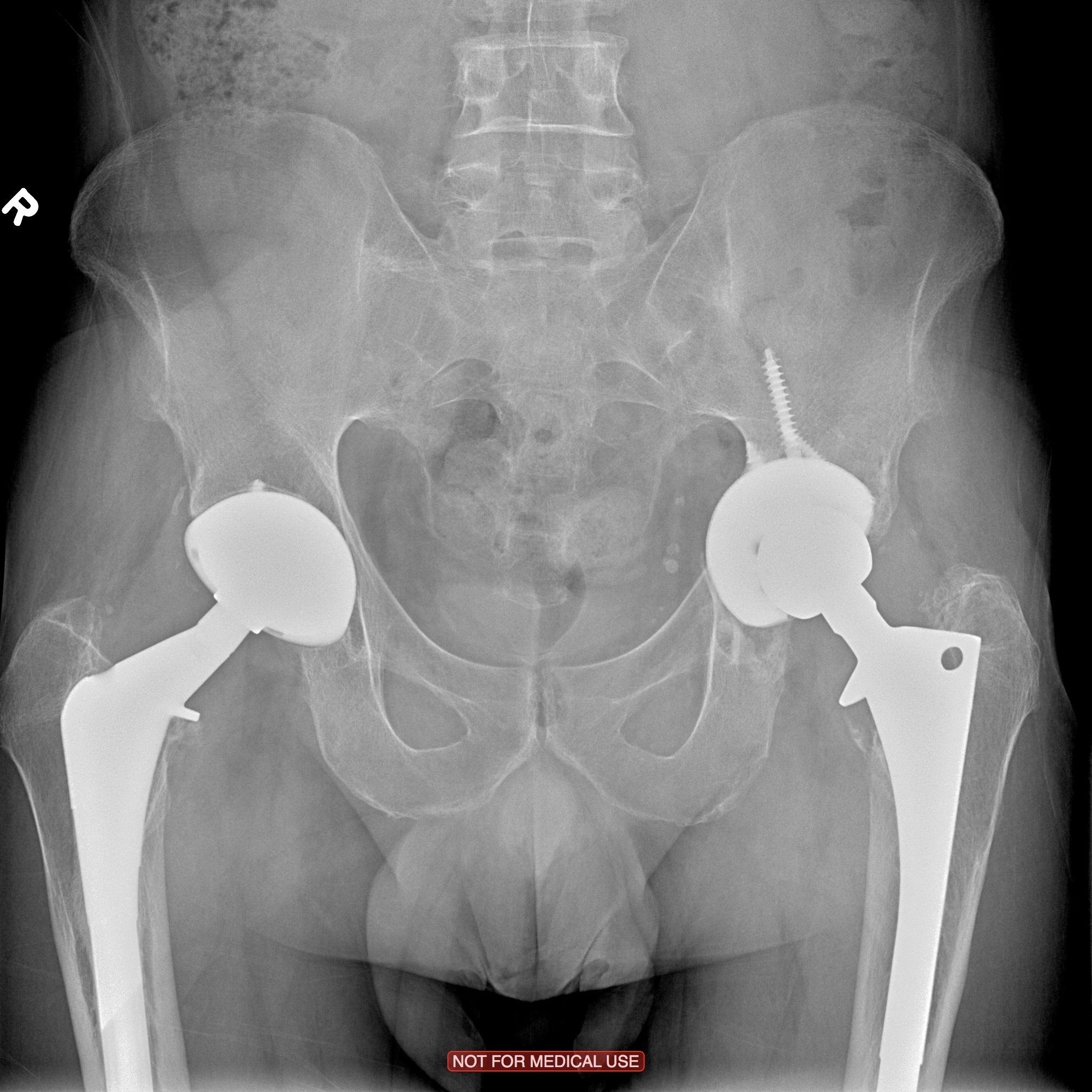
-
Talonavicular Fusion – left foot (2006)
What is it?
This is an operation to “fuse” or stiffen a joint in the middle part of the foot. It fuses together two bones, the talus and the navicular bone – hence “talonavicular fusion”.
Why would it be done?
Talonavicular fusions are done for two main reasons:
- Arthritis of the joints, because of a previous injury that has damaged the joints, ageneralised condition such as osteoarthritis or rheumatoid arthritis, or because the joint is just wearing out for some other reason.
- Severe deformity of the foot, such as a flat foot, a club foot or other deformity. Sometimes these can be corrected by breaking and re-shaping the bones, but in other cases it is best to stiffen the joints in the corrected position, particularly if the joints are already stiff or the foot is weak.
-
Left hip revision surgery (August 4th, 2016)
My left hip had to be revised in 2016 because it had worn out. It was 17 years old. Unfortunately, it was not a complete success, and I was left with permanent sequela: chronic pain, stiffness, and nerve damage in and around the scar (neuromas). The new implant has also caused me to develop a Neurogenic Bladder. And, as it was discovered when a highly regarded orthopedic surgeon in N.J. reviewed my post-op x-rays, a critical piece of bone is missing to support the implant and distribute the load evenly. This likely explains why I have been left with a dysfunctional hip.
-
Cervical damage (from Ankylosing Spondylitis)
My C4 and C5 cervical vertebrae were damaged and fused by the Ankylosing spondylitis disease process.
Ankylosing spondylitis is a type of arthritis that affects the spine. Ankylosing spondylitis symptoms include pain and stiffness from the neck down to the lower back. The spine's bones (vertebrae) fuse together, resulting in a rigid spine. These changes may be mild or severe, and may lead to a stooped-over posture. Early diagnosis and treatment helps control pain and stiffness and may reduce or prevent significant deformity.
-
Cervical Laminectomy and Fusion of Herniated disc at C7/T1
I had Cervical Laminectomy and Fusion done on March 29th, 2019 with Dr Jeff Golan at the Jewish General Hospital. The surgery involved using 10 screws, 5 on each side along with 2 metal rods to fuse the vertebrae from C3 to T1. Despite some ligering neuropathic symptoms in my arms and hands, I feel that the surgery was successful. I no longer have chronic pain in my neck which is great. And, I don't feel as if I lost any mobility which is also great.
The arm pain from a cervical herniated disc results because the herniated disc material “pinches” or presses on a cervical nerve, causing pain to radiate along the nerve pathway down the arm. Along with the arm pain, numbness and tingling can be present down the arm and into the fingertips. Muscle weakness may also be present.
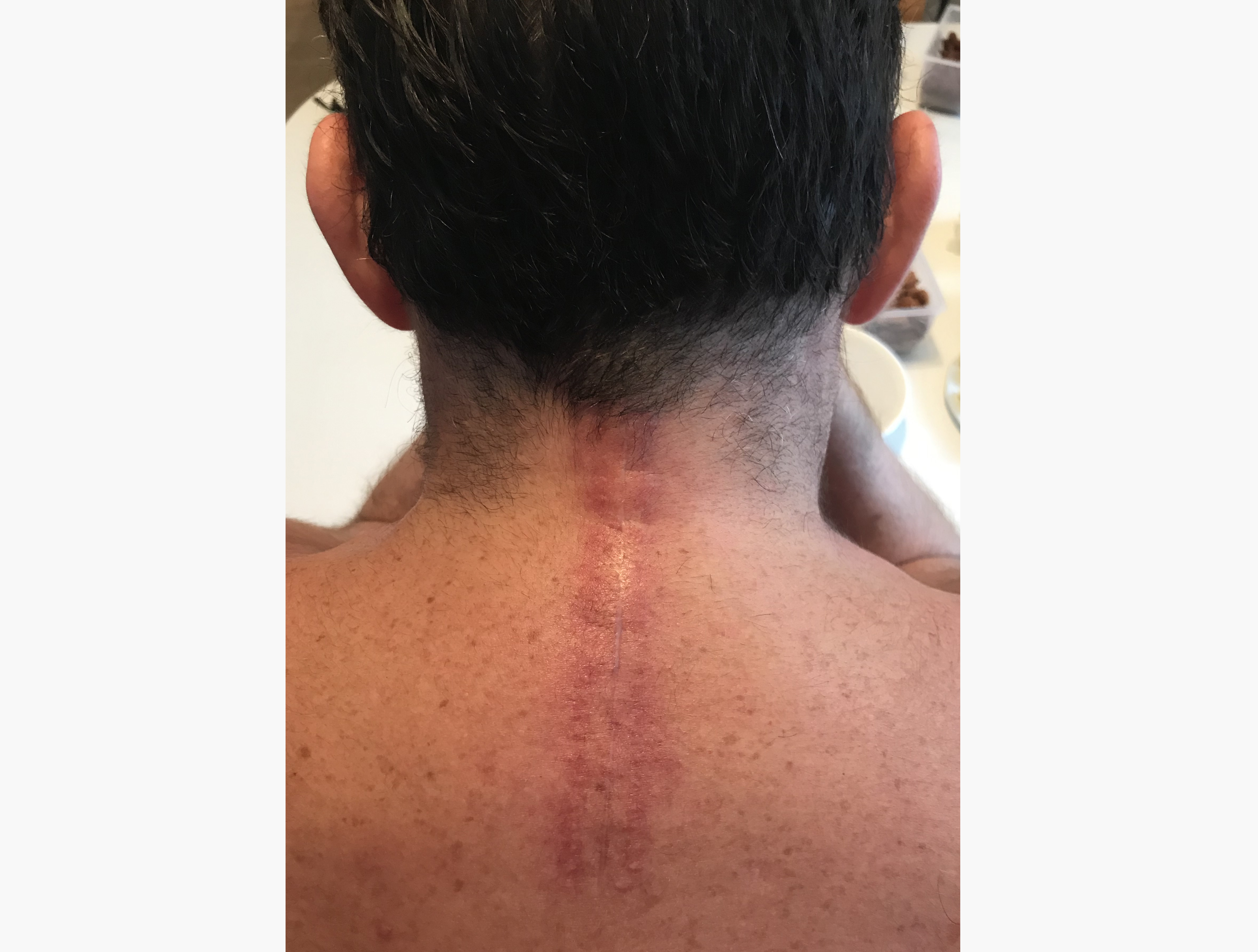
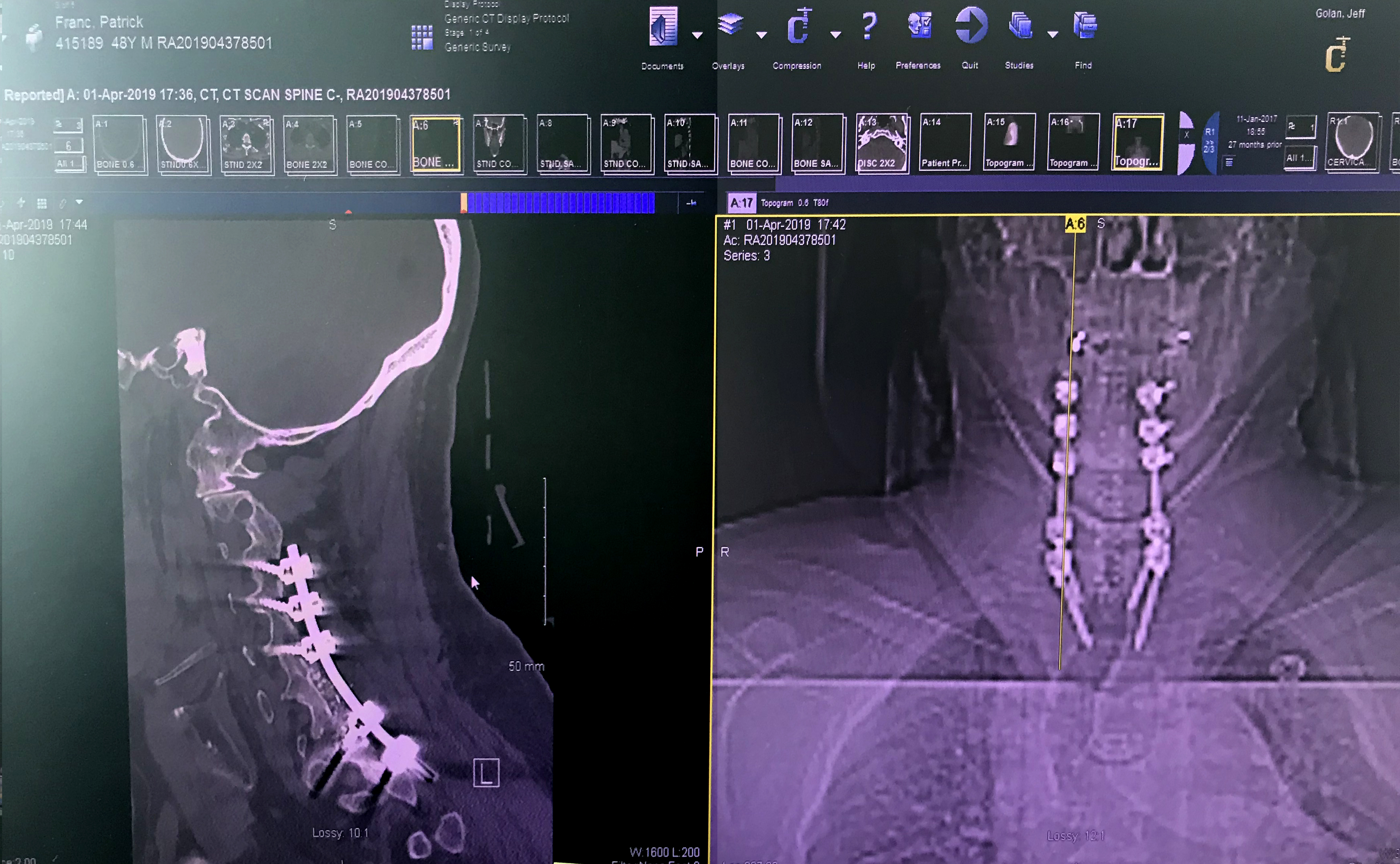
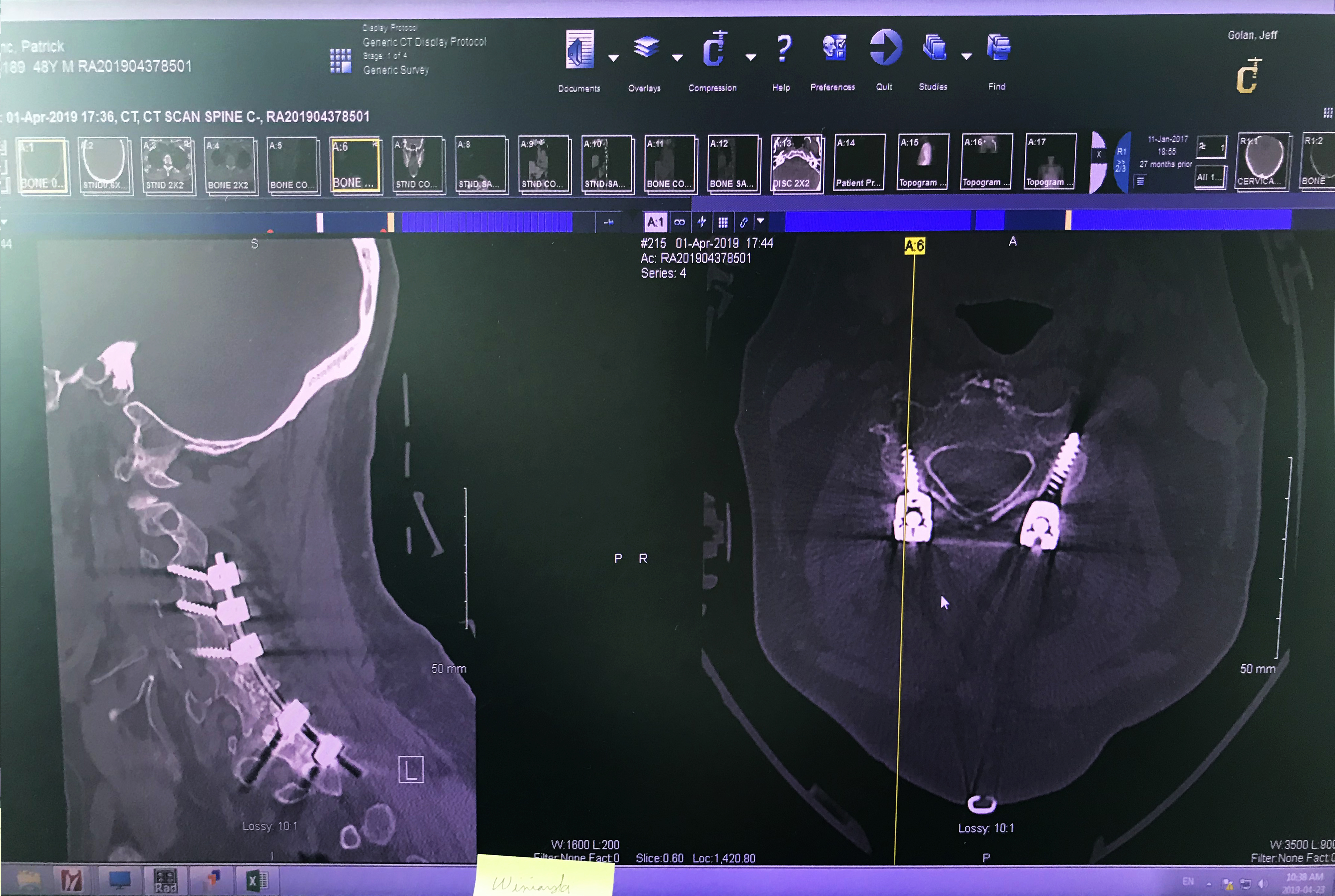
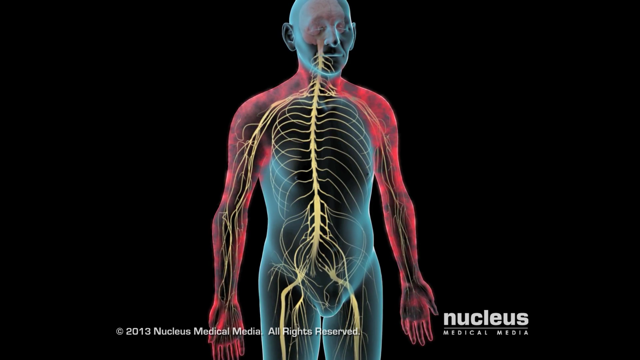


-
Fused sacroliac joints (from Ankylosing Spondylitis)
My sacroliac joints were fused by the Ankylosing Spondilitis disease process - not with surgery.
Sacroiliac joint fusion surgery may be recommended to treat sacroiliac joint pain when nonsurgical treatments are ineffective.
Sacroiliac joint dysfunction can cause pain in the lower back, groin, pelvis, and hips.
In a fusion surgery, a bone graft and/or instruments are used to encourage bone growth over the sacroiliac joint and create one immobile unit. Joint fusion can effectively reduce pain and instability caused by sacroiliac joint dysfunction or inflammation (sacroiliitis).
Most cases of sacroiliac joint pain can be treated using pain medication, injection treatments, chiropractic manipulation, and/or physical therapy, and surgery is usually not necessary.
www.spine-health.com -
RIght hip revision (January 17th, 2023)
In 2001, I was fitted with a metal-on-metal hip implant which was supposed to last me my whole life. These implants began failing by the thousands, and there are currently several class action lawsuits in the U.S. against various manufacturers. Mine has been leaching high levels of Cobalt and Chromium into my body since 2015, disastrously affecting my health.
So, after seven years of monitoring my levels, my new surgeon and I decided it was high time the implant came out. I had the surgery done on January 17th. The surgery was beautifully executed and I am progresing much more quickly than expected. Dr Albers out of St-Mary's did a great job.
The toll this hip implant has taken on my health and my life is immeasurable.
Cobalt toxicity is likely the root cause of all of my most recent syndromes and comorbidities, such as:
- Anxiety
- Auditory impairment, deafness (Chronic Eustachian Tube Dysfunction)
- Basal septal hypertrophy (BSH) (heart problems), including heart failure
- Cognitive impairment
- Depression and other mental health conditions
- Nerve problems, such as peripheral neuropathy
- Gastrointestinal issues (I have IBS)
- Heart irregularities (palpitations)
- Irritability
- Kidney problems (I have stage 3a Kidney disease)
- Poor memory and mental fogginess
- Shortness of breath
- Skin rashes
- Thyroid problems
- Tinnitus
- Tremors
- Vertigo

